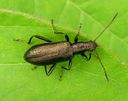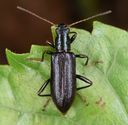Long-jointed Beetles
Lagriinae
Classification
- Phylum: Arthropoda
- Subphylum: Hexapoda
- Class: Insecta
- Order: Coleoptera
- Suborder: Polyphaga
- Superfamily: Tenebrionoidea
- Family: Tenebrionidae
- Subfamily: Lagriinae
Pronunciation
How to pronounce Lagriinae: //ləˈɡriː.ɪ.naɪ//
These audio files are automatically generated. While they are not always 100% accurate, they are a good starting point.
Images






Summary
Lagriinae is a subfamily of long-jointed beetles within the family Tenebrionidae, notable for its medium-sized adults, unique tarsal formula, and ecological role in decomposing plant material. With over 270 genera, they exhibit a wide diversity and can be found in various habitats, primarily feeding on decaying vegetation.
Physical Characteristics
Adults of Lagriinae are mostly medium-sized (5-12 mm) with a 5-5-4 tarsal formula. The eyes are usually deeply emarginate and can partially surround the antennal bases, which are hidden by canthi. The last antennal segment is often either the longest or the widest and is sometimes sexually dimorphic. The head is generally at least as broad as the pronotum and constricted behind the eyes. The pronotum is typically much narrower than the base of the elytra, broadest at its base, and with sinuate or constricted sides.
Identification Tips
Look for the distinctive head and pronotum shape, along with the deeply emarginate eyes and unique antennal characteristics.
Habitat
Lagriinae larvae can typically be found in decaying vegetation, particularly in stumps and under bark.
Distribution
Lagriinae includes more than 270 genera worldwide, with approximately 35 species found in 8 genera across different regions, particularly in specific areas of significance.
Diet
Larvae feed on decaying vegetation in stumps and under bark.
Ecosystem Role
Lagriinae play a role in the decomposition process by feeding on decaying plant material, aiding in nutrient recycling.
Similar Taxa
- Arthromacra
- Rhypasma
- Casonidea apicicornis
- Statira
- Paratenetus punctatus
Tags
- Lagriinae
- Long-jointed Beetles
- Tenebrionidae
- Insects
- Coleoptera